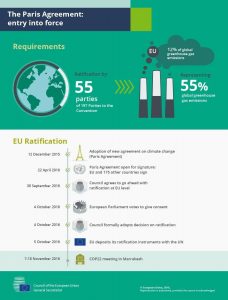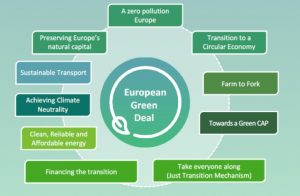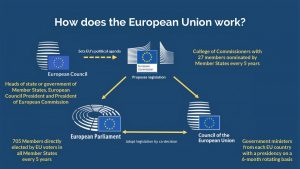Written by: Semra Tosuni
Reading time: 8 minutes
The European Climate Law was published in the Official Journal on 9 July 2021 and entered into force on 29 July 2021 after the Council of the European Union and the European Parliament made an agreement. This agreement enabled the European Union to participate at the Virtual Leaders Summit on Climate organized by the United States of America in April 2021.
This summit was initiated by Joe Biden, after fulfilling his promise to bring back America into the Paris Agreement. The European Union (EU) and its Member States are parties to the Paris Agreement which means that the agreement is binding in the territory of the Member States and should be taken into consideration by EU institutions when they legislate. It’s part of their international obligations.
We can see that the European Union plays a leading role in the field of environment. The organization contributed to the negotiation of the Paris agreement in 2015 and keep trying to influence states around the world to be more aware of climate issues. In this perspective, the leaders of EU have been able to take different acts to achieve the objectives set by the Paris Agreement and the Green Deal.

The Paris Agreement is a legally binding international treaty on climate change.
In what context was the Climate Law adopted?
This regulation arrives after main initiatives that were taken from the European Commission within the framework of the Green Deal. The leaders of the European Union have been able to see that climate change and the degradation of the environment are a threat to EU and the rest of the world. Ursula Von Der Leyen, President of the European Commission said that she wants Europe to be the first climate-neutral continent in the world by 2050.

The European Green Deal is a set of policy initiatives by the European Commission with the overarching aim of making the European Union (EU) climate neutral in 2050
The adoption of the European Green Deal was proposed by the European Commission to transform EU economy and society to meet climate ambitions. As the President of the Commission said, the goals are to make energy, transport and taxation policies in EU fit for reducing net greenhouse gas emissions by at least 55% by 2030. For this objective to be achieved, the Member States have to fully cooperate with the European Union. That’s exactly the reason why the European Commission offers to take a regulation that will bind in the legal order of the Member States.
For information, a regulation does not imply for the Member States to transposed it in their legal system unlike the application European directives. That means that a regulation enters into force directly according to the article 288 of the Treaty on the Functioning of the EU (TFEU). Indeed, they always have direct effect on national legal systems. It’s called the principle of direct effect in European law that has been enshrined by the Court of Justice in the judgement of Van Gend en Loos of 5 February 1963.
As a result of all this previous context, a regulation is adopted: Regulation (EU) 2021/1119 of the European Parliament and of the Council of 30 June 2021 establishing the framework for achieving climate neutrality and amending Regulations.
The Vice-president of the European Commission, Frans Timmermans, said it was a historical moment for the European Union which sends “a strong message to the world: our commitment in favor of a neutral EU in climate field that will guide our policies for the 30 following years”. Even though it is better than the goals established in 1990 that were a 40% reduction of greenhouse gases, the European Parliament judged that this goal was insufficient, and they had asked for a reduction of 60% instead of 55%. But the 55% reduction target was the one confirmed by the Council of the European Union.
How a law is adopted in the European Union?
The process of adopting a European law go through the role of Parliament and the role of the Council. Indeed, most EU laws are adopted using the ordinary legislative procedure, that was the case with the European Climate Law. It’s the situation where the European Parliament which is directly elected by the European citizens (for 5 years) and the Council of the European Union which is composed by the representatives of the 27 European Union countries (government ministers), have to agree and negotiate on a legislative proposal that is submit by the European Commission. Also, there are different legislative procedure, but the ordinary procedure is commonly used and it’s the one that was used for the Climate Law.
The European Commission is known to be the “guardian of the treaties” which legitimates her legislative initiative. An agreement between the Parliament and the Council is primordial for a proposal to become a European law. They have the opportunity to amend the text, to review it until they come to an agreement. Both of them co-legislate in EU since the Treaty of Lisbon. This procedure is set out in articles 289 to 294 of the TFEU.
Let’s also remind that the Council of the European Union has a “rotating presidency”, it changes every 6 months. Actually, it’s Slovenia who has the presidency, after it will be France. It means that they have the opportunity, during these 6 months, to propose projects for which they have a strong interest.

The Process of adopting an European Union
The objectives of the European Climate Law
The European Climate Law sets diverse objectives such as long-term direction of travel for meeting the 2050 climate neutrality objective and a 55% reduction of net emissions of greenhouses gases before 2030. One of the other objectives is to provide predictability for investors and other economic actors and to create a system for monitoring progress and take further action.
To satisfy those objectives, the Climate law establish a European Scientific Advisory Board on Climate Change that will provide independent scientific advices. The European Union will also put in place stronger provisions on adaptation to climate change and a strong coherence across Union policies with the climate neutrality objective. The Commission will be able to take recommendations to Member States that have difficulties to take action for the climate neutrality objective. This act should be followed by the countries otherwise they will have to respond if they don’t. The cooperation and the solidarity of the Member States is really important for this project. Also, every five years, the Commission will evaluate if the European actions and the national actions are compatible with the objectives set out in the law.
Also, the European Commission has proposed several directives and regulations to help achieve the new objectives. It’s called the “fit for 55 package”. It includes wide-ranging policy area such as energy efficiency, energy performance of building, land use, energy taxation, effort sharing and emissions trading, a carbon border adjustment mechanism to help reduce the risk of carbon leakage, also circular economy action plan, biodiversity strategy and also, to finish, farm to fork strategy.

Janusz Wojciechowski, Frans Timmermans, Adina Valean, Ursula von der Leyen, Paolo Gentiloni, Kadri Simson, Virginijus Sinkevicius | Photo credit: European Commission Audiovisual
The results of previous environmental objectives in Europe
As we said earlier, the European Climate Law is a binding text just like the Paris Agreement. This law was taken in 2021 which seems a little late because in the light of climate issues that have been there for much longer. However, with the adoption of the Paris Agreement, the European Union and its Member States had to submit to the objectives included in the agreement because of their international obligations.
One of the objectives of the Paris Agreement was to keep global warming below 2°C in relation to pre-industrial levels while continuing action to limit the temperature increase to 1.5°C. That is one of the many reasons that lead to the adoption of the European Climate Law and the target of a 55% reduction by 2030.
However, the actual situation in Europe these last month shows us the urgence of the environmental situation. Indeed, the recent floods and fires in some Member States of the EU, including Germany and Greece for example, demonstrate the insufficient action on environment. For that reason, the Green political party of the State members ask for the recent situations to be take into consideration and they also denounce the inadequacy of the actions undertaken within the framework of the European Union. Furthermore, the global inventory conducted by Climate Action Tracker shows that, with the current policies adopted in the EU level, global warming would reach 2.7°C in the future.
That is why, a few weeks from the Glasgow Summit, European Union political leaders at the European Commission denounce the late progress on environment. Indeed, Philippe Tulkens, Head of Unit at the European Union Reaserch and Innovation on Climate, has declared that “action both on limitation and adaptation is too slow” to limit the rise of the global temperature to 1.5°C. We can observe that actions differ from one Member State to another and many of them have not yet take sufficient and necessary measures to meet the EU target. The Climate Action Tracker rates EU as “insufficient” that means that the “EU’s climate policies and commitments need substantial improvements to be consistent with the Paris Agreement’s 1.5°C temperature limit”. This leads us to think about what the EU next action would be to overcome delays established by the Climate Law and the Paris Agreement.

European Union Side Events – COP26
The Glasgow Summit: the opportunity for the European Union to affirm her position on climate issues
On 31 October 2021, COP26 has opened in Glasgow. It is the 26th annual United Nations Climate Change Conference under the British Presidency, in fact, Circle of Sustainable Europe (CoSE) has been admitted as an official Observer at this important Summit, as 4 of our delegates represented us in Glasgow. However, the European Commission and the European Council will represent EU at the summit. The Commission is represented by the president, Ursula Von Der Leyen. The Council is represented by Charles Michel and finally, Slovenia, which is has the presidency at the Council of the European Union will have a place in the meetings by representing the 27 Member States.
The European Council has an important role in an international agreement. His mission is to approve negotiating directives and to conclude agreements. EU can conclude an international agreement with non-Member States but also international organizations such as the United Nations. The procedure of negotiation and adoption is set by the article 207 et 218 of the TFEU.
Different subjects will be discussed at COP26. Countries will be asked to come forward with ambitious 2030 emissions reductions targets that align with reaching net zero by 2050. Also, the goal is to protect communities and natural habitats especially for countries affected a lot by climate change. Financial questions will be discussed and as you may know, the EU is already donating to developed countries to improve their environmental action. And finally, the COP26 will be the perfect occasion to remind us that we could make a change for the environment only if we all work together.
That’s why, as we saw earlier, this “pre-reminder” by the European Commission and the European Parliament, two weeks before the opening of the summit, suggests that the European Union would like to play an important role in the fight against climate change, even at an international level, by stepping up its environmental action, but also by encouraging other countries in the world to improve theirs.
Moreover, with the adoption of the European Climate Law, it has made both the new emissions reduction target and the climate neutrality goal binding which is a major step in climate mitigation. The EU seems to take an important place in the negotiations that will take place during the COP26.

Circle of Sustainable Europe (CoSE) admitted as Observer to the UN Climate Change Conference

“Semra Tosuni is our content creator from France and is a law student at Jean Moulin University in Lyon. She joined Circle of Sustainable Europe (CoSE) because she believes it gives her the opportunity to be part of the change and also to share her knowledge by writing articles about climate change in order to raise awareness.
References:
https://www.consilium.europa.eu/en/press/press-releases/2016/10/04/adoption-paris-agreement/
https://ec.europa.eu/clima/eu-action/european-green-deal/european-climate-law_en
https://eur-lex.europa.eu/legal-content/EN/TXT/?qid=1626354413250&uri=CELEX%3A32021R1119
https://ec.europa.eu/info/strategy/priorities-2019-2024/european-green-deal_fr
https://eur-lex.europa.eu/legal-content/EN/TXT/?uri=LEGISSUM%3Al14547
https://ec.europa.eu/info/law/law-making-process/adopting-eu-law_en
https://ec.europa.eu/commission/presscorner/detail/en/ip_20_1940
https://climat.be/actualites/2021/loi-europeenne-sur-le-climat-une-avancee-decisive
https://climateactiontracker.org/countries/eu/
https://eur-lex.europa.eu/legal-content/FR/ALL/?uri=CELEX%3A61962CJ0026


